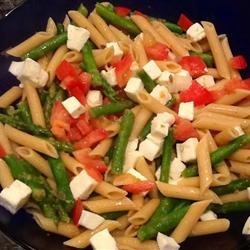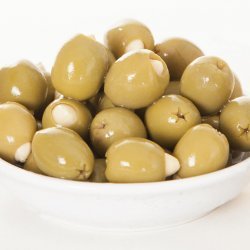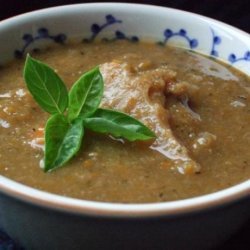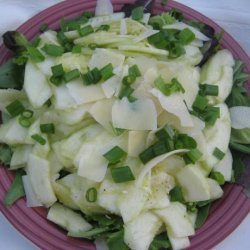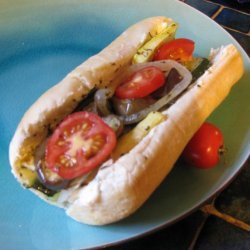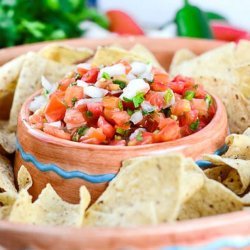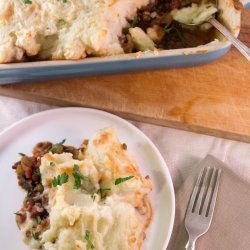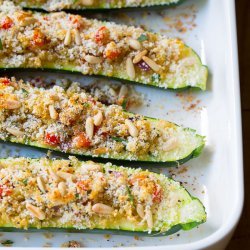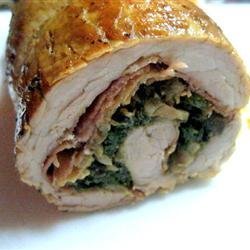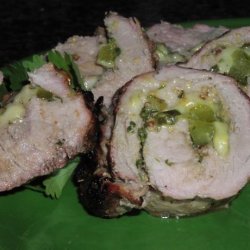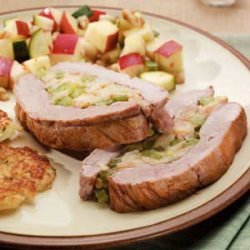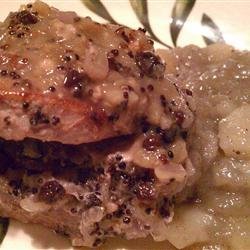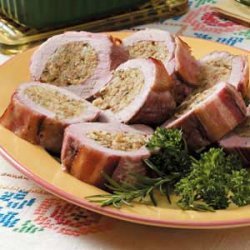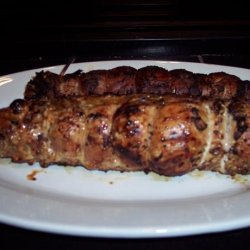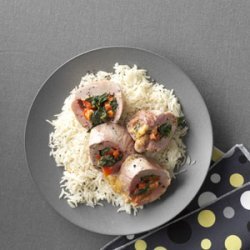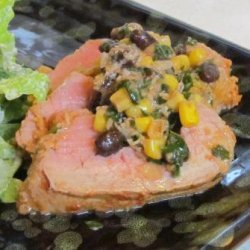Ingredients:
- two pork tenderloins
- 1/4 cup grated parmisian cheese
- trim from the tenderloins , whacked up into very tiny bits
Directions:
- This dish lends itself to all kinds of interesting creativity with a fairly low risk of failure.
- James Beard claims that one pork tenderloin will feed one person. But we all know what James Beard looked like. I figure one tenderloin per two persons with a bit left over. I picked up a 4-pack of them recently at a warehouse store for $20. That's $2.50 per person for the meat, which is a pretty good deal.
- MEAT PREP
- Pork tenderloins are about 12 inches long and 2-3 inches in diameter. They are tapered at one end (often to a very thin point that's fairly useless). If you buy at high-end butcher stores you'll sometimes see trimmed tenderloins that are about half this length and cost much more. I think it's better to buy untrimmed, which also allows you to cut the ends off after cooking for a nicer presentation.
- Pork tenderloins have a silverskin of membrane. Using a sharp knife, trim off some of this. I usually don't get too carried away here, but do try to break up the silverskin into thinner bits. If you leave it entirely intact it will tend to shrink during cooking and sort of pinch the meat.
- If the thin end is very pointy, cut that off. If the thick end has an extra lobe of paler meat (leftover from when separated from the loin) you can trim that down or off as well. if there are huge ugly globs of fat, those can get trimmed, but normal surface fat can be left alone - it will render off during cooking.
- STUFFING PREP
- You want to make a hole down the length of the meat to allow stuffing. There are a bunch of ways to go about this, I'll describe the method I use, which I think is pretty easy and more importantly - safe. I'll assume you are right handed, but if you aren't, just reverse everything.
- Place the meat on a cutting board with the thicker end on the right and the thinner on the left. Take a thin boning knife and place it parallel to the meat in your right hand, with the sharp edge pointing away from you. Place your left hand flat on top of the meat and press down a bit. Insert the knife into the middle of the thick end.
- Slowly and carefully work the knife through the meat. Use your left hand to both stabilize the meat and to judge where the knife is. Keep the knife in the center of the meat. Keep your left hand flat on the top! You don't want to poke it out either side, or even worse out of the top (and into your hand!). This sounds harder than it is, but pork tenderloin is pretty soft meat, so it really doesn't take much pressure to do this. Ideally, you want the point of the knife to end up poking out the small end of the meat. It's OK if the knife is too short for this, just stop when you've got the knife inserted as far as you are able. You're just trying to poke a hole at this point. No need to try to widen it out into anything big enough for actual stuffing.
- Carefully remove the knife. You've now got a basic cut through the meat and need to widen it to allow for stuffing. I first insert my sharpening steel into the same hole I made with the knife. You can bunch up the meat to allow the steel to poke out the other side. You can use a dowel or other (clean) pencil thickness rod you may have around.
- Remove the steel. Next, poke in your index finger and carefully widen out the hole some more. Do this from each end of the meat. Don't worry if you make a hole in the side of the meat. Next time just be more careful. Whew! All done!
- MAKING THE STUFFING
- The stuffing can be anything you like. A few guidelines:
- 1) Have some fat in it. Tenderloins are pretty lean and the fat in the stuffing helps to keep them moist.
- 2) If using vegetables that need a fair amount of cooking (ie, onions, carrots, celery, bell peppers), sauté them first. Allow to cool before stuffing
- 3) If using only vegetables and they are high in water content (ie, mushrooms, squash, zucchini), you may also want to sauté them to drive off some of the liquid. If they don't make up a large proportion if the stuffing, you can leave them uncooked.
- 4) Cut whatever you are using up into small enough pieces that you'll be able to stuff it easily.
- 5) Binders and starches such as corn bread, bread crumbs, rice (cooked), or couscous also work well. If you are including something very very high it fat (such as charizo or bacon) either cook off some of the fat first, or include some sort of binder. Maybe both.
- 6) I'm going to guess you need between half a cup and a cup of stuffing per tenderloin.
- Mix together, uncooked, until well bound. Set aside.
- STUFFING THE MEAT
- Start at the fat end. Poke some of the stuffing into the hole and use your thumb or finger to push it down the length of the meat. Do it a bit at a time. From time to time, squeeze the meat (like a toothpaste tube) to get the stuffing to move more down the meat. Stuff from the thinner end as well. Don't feel the need to over stuff.
- At this point, you can season the outside of the meat any way you would like and place in the fridge until you are ready to cook.
- COOKING - INSIDE
- Heat oven to 375 degrees. On the stove top heat an oven proof skillet, adding the fat of your choice. Use the smallest skillet that will comfortably fit the number of tenderloins you are attempting to cook. Sear all sides of each tenderloin (3-4 minutes per side) and then place the skillet directly into the oven. Cook for 20-30 minutes or until done to your liking.
- COOKING - GRILL
- Build a hot fire on one side of the grill. Grill the meat over direct heat for 3-4 minutes per side. Then move the meat to the side, cover the grill and allow to cook for around 20-30 minutes, or until done to your liking.
- COOKING - FINISHING
- I cook pork to 140-145, which will leave it a bit pink. If you like it well done, pull it from the oven at 150-55. During resting, the temperature will rise up into the safe zone (or as I refer to it, the dry and overcooked zone). Actually, this method is pretty forgiving, because the interior of the meat is basted by the stuffing.
- Rest on a cutting board for at least 10 minutes. Slice about 1/4-1/2 inch thick on a bias (which makes the center look even cooler).
- Served it with a basic red sauce that I had slow cooked earlier in the day, some grilled mushrooms and asparagus. Topped the asparagus with some more of the hotel butter I had left over from the day before.
Nutrition Facts
| Amount Per 1 Serving | |||
| Calories | 6.21 Kcal (26 kJ) | ||
| Calories from fat | 0 Kcal | ||
| % Daily Value* | |||
| Total Fat | 0g | 0% | |
|---|---|---|---|
| Sodium | 0.89mg | 0% | |
| Potassium | 135.75mg | 3% | |
| Total Carbs | 0.89g | 0% | |
| Dietary Fiber | 0.3g | 1% | |
| Protein | 0.89g | 2% | |
| Vitamin C | 10.1mg | 17% | |
| Iron | 0.3mg | 2% | |
| Calcium | 6.2mg | 1% | |
| Amount Per 100 g | |||
| Calories | 21 Kcal (88 kJ) | ||
| Calories from fat | 0 Kcal | ||
| % Daily Value* | |||
| Total Fat | 0g | 0% | |
|---|---|---|---|
| Sodium | 3mg | 0% | |
| Potassium | 459mg | 3% | |
| Total Carbs | 3g | 0% | |
| Dietary Fiber | 1g | 1% | |
| Protein | 3g | 2% | |
| Vitamin C | 34mg | 17% | |
| Iron | 1mg | 2% | |
| Calcium | 21mg | 1% | |
* Percent Daily Values are based on a 2000 calorie diet. Your daily values may be higher or lower depending on your calorie needs.
Find out how many calories should you eat.
Get Your Recipe of Health!
Follow RecipeOfHealth on Facebook!


